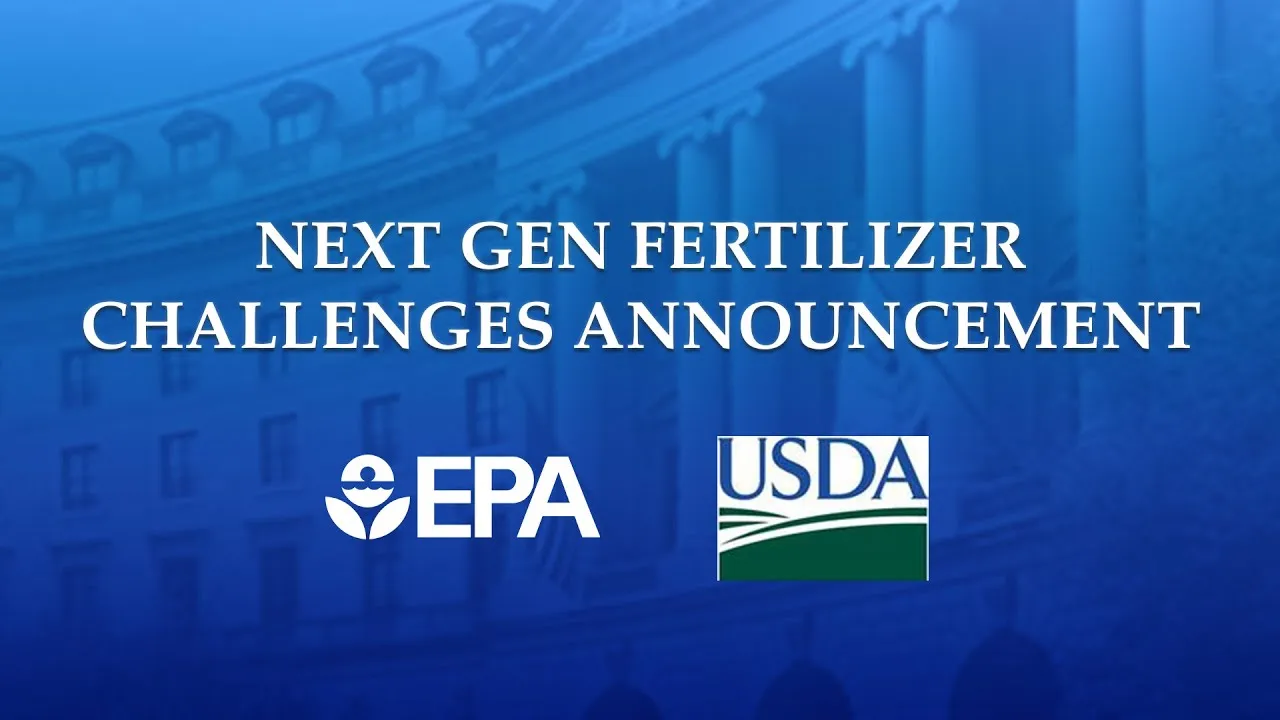


USDA und EPA geben Gewinner der Next Gen Fertilizer Innovations Challenge bekannt
WASHINGTON, 19. Oktober 2021 – Das US-Landwirtschaftsministerium und die US-Umweltschutzbehörde (EPA) haben heute die Gewinner der Next Gen Fertilizer Innovations Challenge bekannt gegeben. Es handelt sich um den zweiten Teil einer zweiteiligen, gemeinsamen Partnerschaft und eines Wettbewerbs von USDA und EPA zu Düngemitteln mit höherer Effizienz (EEFs) zur Förderung der landwirtschaftlichen Nachhaltigkeit in den Vereinigten Staaten. Ziel des Wettbewerbs ist es, die Effizienz von Düngemitteln zu verbessern, um die Ernteerträge zu steigern und gleichzeitig die Auswirkungen von Düngemitteln auf die Umwelt zu reduzieren.

Die Gewinner des Wettbewerbs reichten Konzepte für neuartige Technologien ein, die die Umweltauswirkungen von Stickstoff und Phosphor aus der modernen Landwirtschaft reduzieren und gleichzeitig die Ernteerträge erhalten oder steigern können. Die prämierten Lösungen nutzen Nanopartikel, die weniger Dünger benötigen und Nährstoffe bei Bedarf an wachsende Pflanzen abgeben. Anschließend werden sie biologisch zu unschädlichen Substanzen oder sogar Nährstoffen abgebaut. Sie ermöglichen ein stärkeres Pflanzenwachstum bei gleichem oder geringerem Düngeaufwand und bieten weitere Ansätze.
“Farmers, ranchers, and foresters are well-positioned to be leaders in tackling climate change through technological innovation,” said Acting USDA Chief Scientist Hubert Hamer. “Through programs like the Next Gen Fertilizer Innovations Challenge, USDA is partnering with the private sector to find new climate-smart solutions that are good for farmers and good for the environment.”
“The goal of the challenge is to develop and use innovative and affordable technologies to reduce environmental impacts of modern agriculture on our air, land, and water, while maintaining agricultural productivity and profitability,” said Wayne Cascio, acting principal deputy assistant administrator for science for EPA’s Office of Research and Development. “We are excited about the possibilities and continued new work in this area.”
The winning concepts include a range of solutions that can improve environmental outcomes, including reduced nitrous oxide emissions—the largest source of greenhouse gas emissions from agriculture— while maintaining or increasing crop yields.
Zu den Gewinnern gehören:
Lösungen der Stufe 1 (17.500 USD Preis):
Dr. Christopher Hendrickson, Aqua-Yield Operations LLC, Draper, Utah, für einen nanointelligenten Dünger.
Taylor Pursell, Pursell Agri-Tech, Sylacauga, Ala., for “Urea 2.0,” which replaces the conventional urea core with a customizable mixture of materials to provide fertilizers tailored to local needs.
Lösungen der Stufe 2 (10.000 US-Dollar Preis):
Dr. Kuide Qin, Verdesian Life Sciences, Cary, NC, für den Einsatz innovativer Mischungstechnologien zur Verbesserung der Leistung des Industriestandards Nitrapyrin für eine längere Wirksamkeit, weniger Nitratauswaschung und Verhinderung der Korrosion landwirtschaftlicher Geräte.
Dr. Catherine Roue, Fertinagro Biotech International, Portage, Mich., for “Phosphate Liberation Booster” technology, which uses secretions from phosphate-starved plants to boost plant uptake so less fertilizer may be added and legacy phosphorus can be accessed.
Chandrika Varadachari, Agtec Innovations Inc., Los Altos, Calif., for “Smart-N,” which is a smart-fertilizer that releases nutrients on-demand by the crop and which creates a chemical “cage” for urea that dissolves into plant nutrients.
Tier-3-Lösungen (lobende Erwähnung):
Dr. Jaroslav Nisler, Institut für experimentelle Botanik, Tschechische Akademie der Wissenschaften, Tschechische Republik, für die Verwendung von Derivaten des Pflanzenwachstumshormons MTU, das zu längeren Wachstumsperioden, Schutz vor Stress, größeren Pflanzen und potenziell weniger Nährstoffverlust pro Einheit des ausgebrachten Düngers beiträgt.
Dr. Leanne Gilbertson, Civil and Environmental Engineering Department at the University of Pittsburgh, Penn., for creating a “protected fertilizer package,” which can carry nutrients through soil pores to the area around the plant roots.
Dr. Robert Neidermyer, Holganix LLC, Aston, Penn., for “Bio 800+,” a microbial inoculant that harnesses the power of over 800 species of soil microbes, kelp, and other soil amending ingredients to promote greater crop production and plant health.
Paul Mullins, Brandon Products Ltd., Ireland, for “BBS-1,” a biostimulant derived from seaweed extract that is applied as a fertilizer coating to improve nitrogen-uptake in root cells.
USDA und EPA koordinieren die EEF-Herausforderungen mit dem Fertilizer Institute (TFI), dem International Fertilizer Development Center (IFDC), The Nature Conservancy (TNC) und der National Corn Growers Association (NCGA).
The competition launched on August 26, 2020. Part two of the first challenge, “EEFs: Environmental and Agronomic Challenge,” is ongoing. More information can be found at: www.epa.gov/innovation/next-gen-fertilizer-challenges.
USDA touches the lives of all Americans each day in so many positive ways. In the Biden-Harris Administration, USDA is transforming America’s food system with a greater focus on more resilient local and regional food production, fairer markets for all producers, ensuring access to safe, healthy and nutritious food in all communities, building new markets and streams of income for farmers and producers using climate smart food and forestry practices, making historic investments in infrastructure and clean energy capabilities in rural America, and committing to equity across the Department by removing systemic barriers and building a workforce more representative of America. To learn more, visit www.usda.gov.
-
Zinc Chloride: a reliable stabilizer for ice dye color salts in the dye industryNachrichtAug.11,2025
-
Propargyl Alcohol: A Multifunctional Chemical Additive in the Industrial FieldNachrichtAug.11,2025
-
Phosphorus Pentasulfide: a special material that combines moisture absorption and basic chemical valueNachrichtAug.11,2025
-
Natural Pesticides: The Environmental Choice for Green Prevention and ControlNachrichtAug.11,2025
-
Grass Pesticide: the invisible guardian of green lawnsNachrichtAug.11,2025
-
Dimethyl Sulfoxide: Key Assistance in Sample Management and Drug ScreeningNachrichtAug.11,2025
-
Uncover the Benefits of Sodium ChlorateNachrichtJun.24,2025


















